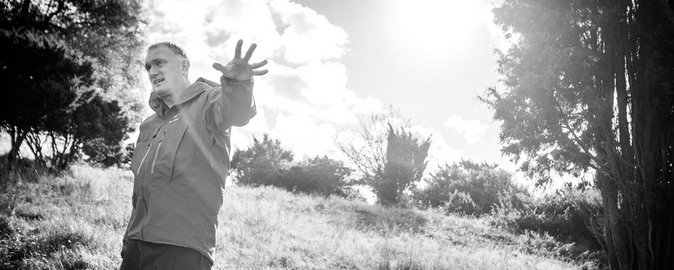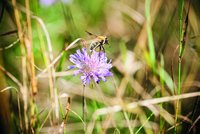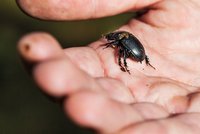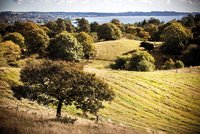- Education
-
Research
Current research
Talent
-
Collaboration
Businesses
Government agencies and institutions
Alumni
-
About AU
Organisation
Job at AU
To protect nature we have to tame it. Does this sound contradictory? If so, read what transpired when AUgustus followed Morten DD on a tour of Mols Bjerge National Park, where he is fighting to preserve threatened species.
2013.06.06 |

“The rare earth-boring dung beetle lives in cow pats. The female digs a deep tunnel in the ground underneath the cow pat – the tunnel can reach a depth of 60 cm and has several side tunnels with ‘nurseries’. Mols Bjerge National Park has one of the best dung beetle faunas in Denmark because the cows in the area are organic. Conventional cows are treated with vermicides that kill the beetles,” says Morten DD.

The rare brown hoverfly looks like a bumblebee. “Mimicry,” Morten DD explains. “If you look like something that stings, you avoid being eaten,” he says. The fly is in rapid decline all over the country, and probably lives near open springs.“Danish springs are becoming overgrown. Livestock used to keep them open, but today the animals are kept indoors all year round. They’re needed out here,” says Morten DD.

Morten DD is a biologist, nature guide and curator at the Natural History Museum, Aarhus. He spends his days at the Mols Laboratory in Mols Bjerge National Park, the museum’s field station in the national park. Mols Laboratory offers nature guidance, field-based teaching and research facilities. Morten DD has contributed to numerous nature programmes on radio and television, most recently the radio programme Bidt af naturen (Smitten by nature).

“If Denmark’s nature was left to its own devices, this is what the country would look like.”
Morten DD points to a wood that almost looks like a solid wall of intertwined branches. The wood is surrounded by an impenetrable wilderness of nettles several metres tall, ground elder and cleavers with the characteristic green seeds that stick to your clothes.
We are in Mols Bjerge National Park together with Morten DD, nature guide and curator at the Natural History Museum, Aarhus. He spends his days at the Mols Laboratory, the museum’s field station in the national park. A national park is an area designed to develop, preserve and protect unique Danish nature. However, in Mols Bjerge this is not achieved simply by leaving nature to look after itself. According to Morten DD, many species would simply not survive if the entire Mols Bjerge area became covered by woods.
“Many species are associated with the open cultivated landscape that humans created during 6000 years of primitive agriculture without the use of fertiliser and pesticides,” says Morten DD, who feels at home in the hilly landscape with a view of the Kattegat. Suddenly he squats down.
“Try touching the sand here. It’s warm because the sun can warm it up. Many insects like that. They don’t thrive in dense woodlands. That’s why we don’t let the wood spread throughout the national park. Grazing cows and horses keep the areas open and we even cut the grass in some places. Some might say that this is artificial, but the animals here aren’t artificial,” he says.
Lively cow pats
The untrained eye cannot detect much life in Mols Bjerge on a windy October day like this, but Morten DD can. He regularly looks through his binoculars and points out a rare bird in the distance. He hears rustling in the bushes from a European adder and discovers small lizards staring at us for a few seconds before disappearing into the scrub at lightning speed. A cow pat lies on a slope. Others would hurry past it, but Morten DD sits down and takes the cow pat apart with his fingers. The light brown, soft interior is teeming with life: beetles, larvae, mites. Morten DD picks up a large black and blue beetle in his hand.
“This is a rare earth-boring dung beetle. It lives in cow dung and is entirely dependent on the cows here. One year without cow dung and there would be no earth-boring dung beetles. Although they’re closely linked to the cultivated landscape – being dependent on the cows we leave here – nobody would argue that they’re not part of nature,” he says.
“Basically, we’re trying to find out which species need to be prioritised. We try to make room for those,” he adds.
Many interests
Mols Bjerge National Park serves several purposes. It is not only about promoting biological diversity – it is also about outdoor life, tourism, local interests and collaboration between politicians, researchers, farmers and others. Morten DD encounters considerable willingness in this area to cooperate in his work to promote biological diversity – also called biodiversity. However, it can be difficult to create a balance between the many different interests, especially because biodiversity has no immediate public appeal.
“When people suddenly hear that you can get money for the national parks, they don’t think: ‘Good, we finally have money to spend on the Maid of Kent beetle.’ They typically think: ‘Now we can get a track or a bird tower.’ People are a bit scared of biodiversity. They think it’s incredibly difficult. You have to communicate it properly,” he says.
“Previously nature was managed with landscape and agriculture in mind. I’d like to help change that. We need to look more closely at the content of nature,” says Morten DD.
Rare animals
According to the nature guide, the national park can help make a difference for the species that rely on it. Examples are crested cow-wheat, a plant whose only habitat in Jutland is here in Mols Bjerge, and the ladybird spider, which is a highly endangered species. In Denmark, it only lives on the heath in Central and West Jutland – and right here in Mols Bjerge, where it is basically only found on a single slope, which Morten DD reveals.
“The ladybird spider lives underground at this time of year, so we won’t see it today,” he explains and pulls tufts of grass out of the slope.
“The spiders need warmth, so it makes sense to remove a bit of the scrub so the sun can reach it,” he adds.
Morten DD stops to think.
“It’s struggling. We may lose it in the long run,” he says. However, he does not look like someone who is thinking of giving up the fight for the small spider.
An amazing planet
The question as to why we should bother protecting nature at all causes Morten DD to raise his voice.
“We’re part of a big, black universe. Each and every small organism on our planet is more complex than anything else the universe has produced in the past. We live on an amazing planet so we damned well have to look after it with respect and thoughtfulness. It’s our bloody duty to make sure that there’s room for the other species on this planet,” he says.
“Today, people regard nature protection as something irrational, hippie-like ‘back-to-nature’ nonsense. That’s when I say: ‘Listen, the species we’re talking about, if it disappears from here, it’ll never come back. That’s the end.’ It’s not hippie-like – it’s assuming responsibility!” he concludes.
Read more about Mols Bjerge National Park at
www.danmarksnationalparker.dk/English/Mols/